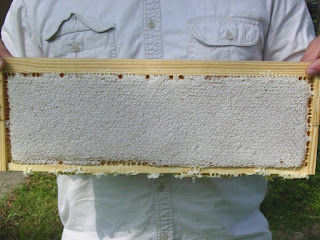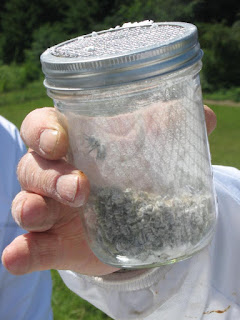 |
| Varroa mites on Bees |
As you know by now, the biggest threat and challenge that we face as beekeepers is the parasite Varroa mite which vector many deadly viruses to our honey bees.
Varroa mites have been very difficult to control despite few new products available to beekeepers, every so often. The latest for us in the USA is oxalic acid, although it has been used for many years in Europe and Canada!
I do believe that first and foremost we should not treat our colonies if we do not have any V. mites. It is counter productive, it increases the resistance to medications, and it is costly. As I said in my previous blog, know your mite level. Monitor and sample your colonies.
What is IPM?
Integrated Pest Management is an approach that is sensitive to the environment, and where the beekeeper reduces the reliance of conventional or "hard" chemical treatments and incorporates multiple tactics to decrease the incidence of pests and diseases, reducing the risk of chemical residues in honey and all hive products while maintaining sustainable treatment options. I teach this approach in my all beekeeping classes. I believe that this strategy makes sense.
 |
| IPM Pyramid |
How to use this IPM Pyramid?
1. Start with prevention:
Choose bees that are from mite-resistant stocks
ex: Russian, MN Hygienic, New World Carniolan or VSH (Varroa Sensitive Hygienic).
Choose your apiary site wisely
Maintain strong colonies with young fertile Queen
2. Cultural/Sanitation:
—Soil well drained, sunny, wind protection, H2O
—Feeding sugar water/ pollen supplement if needed
—Keep clean and healthy site
3. Physical/ Mechanical:
Using drone comb, one per brood box
Using screen bottom board (warmer climate, not recommended in MN)
Bee Protection Gate ( not yet on the market)--Made by Bayer Healthcare's Animal, Health Division.
Bee Protection Gate ( not yet on the market)--Made by Bayer Healthcare's Animal, Health Division.
4. Biological
Researchers are looking into manipulating the sexual behavior of V. mites, or using another insect to weaken the mites. A German company made a Bee-sauna, where every brood frame is steamed, dislodging and killing the mites! Maybe useful in the future for us, the beekeeper!
5. Chemical--Soft and Hard
Soft Chemicals (naturally occurring in nature)
Ex: Apiguard, (Thymol) ; Api Life (Thymol, eucalyptus, camphor)
Hop guard, (Hop)
Mite Away Quick II Strip, (Formic acid)--works well
Oxalic Acid--works well, just approved by EPA
Hard Chemicals ( Developed in labs by scientists)
Ex: Apivar (Amitraz)--works
Apistan ( Fluvalinate) --accumulation in wax and possibly in honey, Varroa resistance. I do not recommend.
Check Mite+ (Coumaphos)--accumulation in wax and in honey, Varroa resistance. I do not recommend.
NOTE
USE PESTICIDES AS A MEAN OF VERY LAST RESORT.
MITE-RESISTANT STOCK IS THE LONG TERM SOLUTION.
SINCE WE KNOW THAT MITES DEVELOP RESISTANCE EVENTUALLY TO ALL NEW CHEMICALS THAT WE CREATE...HONEY BEES WILL DEVELOP RESISTANCE TO MITES IN DUE TIME TOO.
However, I do believe that we need new "blood", new genetics to improve our American bee stocks. As beekeepers, we help ourselves by dividing our best, healthy, populous and overwintered colonies. They already demonstrated that they are survivors, and that they are perfect for our own locality! I wish it would be that simple.
NOTE
USE PESTICIDES AS A MEAN OF VERY LAST RESORT.
MITE-RESISTANT STOCK IS THE LONG TERM SOLUTION.
SINCE WE KNOW THAT MITES DEVELOP RESISTANCE EVENTUALLY TO ALL NEW CHEMICALS THAT WE CREATE...HONEY BEES WILL DEVELOP RESISTANCE TO MITES IN DUE TIME TOO.
However, I do believe that we need new "blood", new genetics to improve our American bee stocks. As beekeepers, we help ourselves by dividing our best, healthy, populous and overwintered colonies. They already demonstrated that they are survivors, and that they are perfect for our own locality! I wish it would be that simple.











